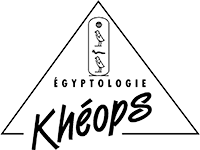NORTH-GALALA
Flint mines from the beginning of the pharaonic period in North Galala
■ Fieldwork dates
2014-aujourd’hui
■ Project directors
François BRIOIS (Ehess) et Béatrix MIDANT-REYNES (CNRS)
■ Participants
Pierre-Antoine BEAUVAIS | Aurore CIAVATTI | Frédéric GUYOT | Hassan MOHAMED | Valérie LE PROVOST | Mohamed GABER | Mohamed HAMDAN | Yann TRISTANT
■ Institutions
- Institut français d’archéologie orientale (Le Caire)
- Laboratoire TRACES, UMR 5608, CNRS, Ehess, Université Toulouse Paul Sabatier
- Fonds Khéops pour l’archéologie
- Labex SMS - Université Toulouse - Jean Jaurès
■ Presentation
In 2014, during surveys conducted in the North Galala Mountains by François Briois and Béatrix Midant-Reynes, a large complex for flint exploitation was identified, stretching in the centre of the Gebel el-Galala el-Baharia, a high limestone plateau located north of Wadi Araba, between the Nile Valley and the Red Sea. The flint extraction complexes and associated knapping workshops spread over a large area in the upstream part of the vast wadi network that crosses the mountains towards the Nile Valley, where the Eocene limestone containing rich flint formations was cut. From the earliest periods of the Egyptian history, the excellent quality of the raw material has aroused interest from flint knappers, who produced tens of thousands of tools intended for the consumption centres of the Nile Valley.
The German botanist Georg August Schweinfurth is the first person to mention in Science in 1885 and in the Bulletin de l’Institut égyptien (BIE) in 1886, the presence, in Wadi Warag and Wadi Sannour, of concentrations of flint flakes, that he correctly interprets as knapping workshops. Despite these early mentions, his discoveries, which take place 20 years before the ones of Wadi Sheikh by Heywood Walter Seton-Karr – the only flint mines then known – remain in silence during more than a century. In 2014, thanks to indications given by the detailed observation of aerial images, the two sites identified by Schweinfurth were located and surveys conducted on a larger area covering almost 600 km2 reveal the presence of several hundreds of flint extraction locations and knapping workshops. Surveys are still on-going and complemented by the excavation of several miner camps related to the receiving and redistribution towards the valley of products coming from the exploitation of the mines, mainly blades, bifacial knives and to a lesser extent, unfinished disks intended for the making of flint bracelets. Relying on the first available radiocarbon dates and the ceramics, occupations range from the Protodynastic period until the Old Kingdom.
The high density of mine sites on such a large area and the exploitation of sometimes very small and isolated deposits indicate that miners have explored the region in a systematic way to extract the best raw material. The important track network crossing the western part of the Galala probably favoured their very good knowledge of the available resources.
Archaeological works on the mines and flint workshops in North Galala were conducted on behalf of IFAO. They benefit from the support of the Fonds Kheops pour l’archéologie and of the LABEX SMS in Toulouse.
■ Principales publications
Briois, F. & Midant-Reynes, B., A recent discovery: the flint mines of north Galala, Egyptian Archaeology 54 (2019): 27-31.
Guyot, F.; Marchand, J. & Petit, C., The 4th Dynasty Flint Quarries in the North Galala Plateau. A Ceramic Approach, Bulletin de la Céramique Égyptienne 28: 183-210.
■ Websites
Ouadi Sannour, sites antiques d’exploitation du silex dans le désert Oriental
Institut français d’archéologie orientale (Ifao)

The Galala mountains and the location of the sites discovered and mentioned by Schweinfurth
(base map D. Laisney, Ifao)

Site WS101. The exploitation trench surrounded by old exploitation dump
.(Photo B. Midant-Reynes)

Site WS 328. Blade core refitted with a core tablet (opening of the striking platform surface)
(Photo B. Midant-Reynes)

Preform of a bifacial knife left at the workshop because of a break occurring during a knapping accident
(Photo B. Midant-Reynes)

WS13 base camp located on a terrace near Wadi Nikhaybar
(Photo B. Midant-Reynes)




















